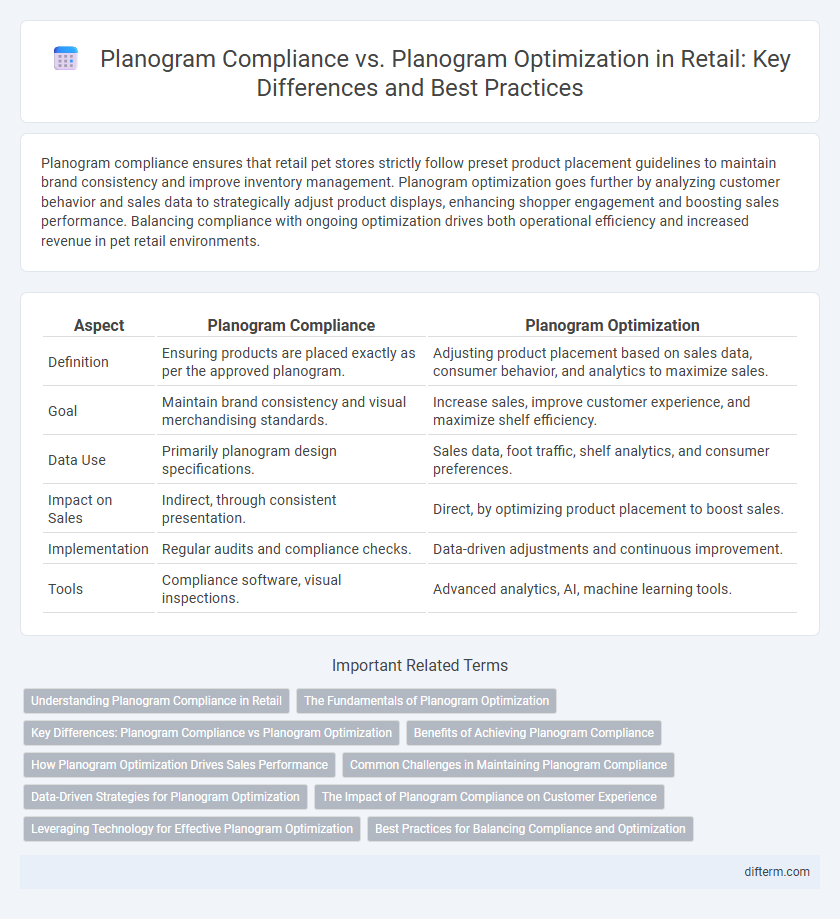Planogram compliance ensures that retail pet stores strictly follow preset product placement guidelines to maintain brand consistency and improve inventory management. Planogram optimization goes further by analyzing customer behavior and sales data to strategically adjust product displays, enhancing shopper engagement and boosting sales performance. Balancing compliance with ongoing optimization drives both operational efficiency and increased revenue in pet retail environments.
Table of Comparison
| Aspect | Planogram Compliance | Planogram Optimization |
|---|---|---|
| Definition | Ensuring products are placed exactly as per the approved planogram. | Adjusting product placement based on sales data, consumer behavior, and analytics to maximize sales. |
| Goal | Maintain brand consistency and visual merchandising standards. | Increase sales, improve customer experience, and maximize shelf efficiency. |
| Data Use | Primarily planogram design specifications. | Sales data, foot traffic, shelf analytics, and consumer preferences. |
| Impact on Sales | Indirect, through consistent presentation. | Direct, by optimizing product placement to boost sales. |
| Implementation | Regular audits and compliance checks. | Data-driven adjustments and continuous improvement. |
| Tools | Compliance software, visual inspections. | Advanced analytics, AI, machine learning tools. |
Understanding Planogram Compliance in Retail
Planogram compliance in retail measures how accurately store shelves match the prescribed layout designed to maximize product visibility and sales. Monitoring compliance ensures consistent brand presentation, prevents stockouts, and enhances customer experience, directly impacting revenue. Effective planogram compliance drives inventory efficiency and supports data-driven merchandising decisions for improved retail performance.
The Fundamentals of Planogram Optimization
Planogram optimization ensures product placement maximizes sales by analyzing shopper behavior, shelf space utilization, and inventory data, moving beyond mere planogram compliance which only verifies adherence to set layouts. Effective optimization incorporates data-driven insights to enhance product visibility and accessibility, driving higher customer engagement and profitability. Retailers employing advanced analytics and AI tools achieve continuous planogram refinement, resulting in improved stock turnover and store performance.
Key Differences: Planogram Compliance vs Planogram Optimization
Planogram compliance ensures that retail shelves accurately reflect the predefined arrangement, maintaining consistency and adherence to corporate standards. Planogram optimization focuses on data-driven adjustments to improve product placement, maximize sales, and enhance customer experience. Key differences lie in compliance's emphasis on adherence versus optimization's goal of continuous performance improvement through strategic modifications.
Benefits of Achieving Planogram Compliance
Achieving planogram compliance ensures consistent product placement, which enhances customer shopping experience and increases sales by making it easier to locate items. Compliance reduces out-of-stock instances and improves inventory accuracy, supporting efficient store operations and minimizing lost revenue. Retailers benefit from maximizing shelf space utilization and driving higher profit margins through adherence to optimized merchandising layouts.
How Planogram Optimization Drives Sales Performance
Planogram optimization enhances sales performance by aligning product placement with consumer behavior and purchase patterns, increasing product visibility and accessibility. Optimized planograms use data analytics and shopper insights to prioritize high-margin and high-demand items, boosting overall sales and inventory turnover. Maintaining planogram compliance ensures that the optimized layout is consistently executed across retail locations, maximizing return on investment and driving revenue growth.
Common Challenges in Maintaining Planogram Compliance
Maintaining planogram compliance poses challenges such as inconsistent shelf labeling, frequent product substitutions, and inadequate staff training, which lead to deviations from the intended visual layout. Inventory discrepancies and real-time stock shortages can disrupt the balance between planogram compliance and optimization efforts, causing reduced shelf productivity and customer dissatisfaction. Frequent planogram updates without effective communication complicate adherence, underscoring the need for robust monitoring systems and automated validation tools.
Data-Driven Strategies for Planogram Optimization
Planogram optimization leverages advanced data analytics and customer behavior insights to tailor product placement, maximizing shelf efficiency and sales performance. Data-driven strategies integrate sales data, inventory levels, and foot traffic patterns to continuously refine product assortment and positioning. Ensuring planogram compliance involves monitoring adherence to these optimized layouts, enabling retailers to maintain consistency and achieve strategic merchandising goals.
The Impact of Planogram Compliance on Customer Experience
Planogram compliance directly influences product visibility and availability, enhancing customer satisfaction by ensuring shelves are consistently stocked and organized according to strategic layouts. Proper adherence reduces shopper frustration, facilitating quicker decision-making and a more efficient shopping experience. High compliance rates correlate with increased sales, stronger brand perception, and improved customer loyalty within retail environments.
Leveraging Technology for Effective Planogram Optimization
Leveraging advanced technology for planogram optimization enhances retail shelf management by ensuring precise product placement based on real-time data analytics and consumer behavior insights. Automated planogram tools improve planogram compliance by minimizing human error and enabling consistent adherence to layout standards across multiple store locations. Integration of AI-driven software supports dynamic adjustments, optimizing inventory levels and maximizing sales opportunities through data-driven decision-making.
Best Practices for Balancing Compliance and Optimization
Achieving a balance between planogram compliance and planogram optimization requires leveraging detailed sales data and customer behavior insights to adjust shelf layouts while maintaining brand standards. Regular audits combined with dynamic planogram software ensure that stores adhere to corporate guidelines while adapting product placements to maximize shelf space efficiency and boost sales. Implementing cross-functional teams that include merchandising, marketing, and store operations fosters collaboration and continuous improvement in planogram strategies.
planogram compliance vs planogram optimization Infographic

 difterm.com
difterm.com